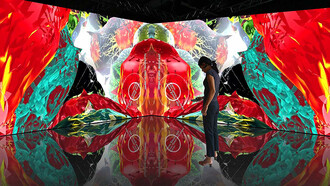Mohamad Hafez opened the Brighton Festival with his first solo UK exhibition in Fabrica. I met him in the gallery, which was once Trinity Chapel, built in 1817.
He gave me a card, which had a certain question written on, first in English then in Arabic: What is home to you? I didn’t know what to say. There were many of these cards, and there was some space on cards for the visitors to fill in with their own definitions. I didn’t know what to write. I excused myself and said that I would send my response after some much needed deliberation. Hafez said that he understood.
Two minutes or so later, I heard the prayer – call for namaz – and I was at home. The sound of the prayer was part of Hafez’s installation: a bazooka hanging in the air, reminiscent of a boat afloat, constructed by many, small, found objects like pipes, broken toys, rusty metal jewellery, and a wooden bowl. I believed in a split second that the prayer I heard came from the mosque next door, as it was around the time of the Friday prayer. But there was no mosque next door to Fabrica Gallery. I was puzzled. Without any contemplation, visualisation or hypnosis, I was transported to my childhood, to my hometown, in the periphery of Istanbul, Turkey. Where I grew up in a house next to a mosque. But is this really what home means to me; I still don’t know.
Hafez, who is a Syrian-born and US-based artist, knows well. “Younger me would have told you that home was a physical place, a geographical location. But older me, now, thinks home is where peace and tranquility are. It’s a state of mind. No longer physical. I am home in Damascus, but home is equally Connecticut.”
His last visit to Damascus was in 2011. He says that the uprising had started then, taking place mostly in the southern cities of Syria. Nevertheless, he had had the uneasy feeling that it may be the last time that he was in Syria.
Damascus is in his everyday life. He creates miniature street scenes of the city. These are intricate installations, hanging as a series of wall displays. The scenes include house facades, parked cars, wooden seats in front of houses, curtains hanging outside of buildings, pretty lamps, calligraphy on the walls, flowerpots, minarets, drying laundry, chimneys, water fountains… Everything except for humans. To create these chaotic yet harmonious installations made of random found objects, Hafez transports himself to a mental place in his studio.
“My studio space up above is full of photos from Damascus and Aleppo. Before I start any piece, I look at these photographs for long hours. I look at many details and charge my eyes with a lot of visual information. I burn incense, drink Syrian coffee with a lot of cardamom… I listen to Sufi music and enchantments. I listen to the water fountain I have in the corner of the studio. It takes twenty minutes and I am in the place. Then I start making.”
There is a strong quality of documentary narrative in his work, although he doesn’t depict actual places. Some of his installations have a sound element, which are the recordings he did in Damascus in 2011. These are sounds of street vendors, conversations in coffee shops, cars passing by and the call for prayer.
Hafez is fascinated by the process of making. He uses a completely different methodology in his artistic practice to his architecture work. He surrenders to the objects; doesn’t take credit for the end result. “Sometimes it starts with the frame, a door, sometimes with a car. I build the scene around it. I am then in the hunt for things to suit the space that I create.”
“Objects call for each other. I see myself as the facilitator for these things to come together. I don’t think taking credit would be right. I put the works on display and study these details, but I have no recollection as to how they came together. It is the process that fulfils me.”
Hafez turns part of Fabrica into a nostalgic place for people from the region, from Syria, Egypt, Lebanon, Turkey… The lost past, belonging to some of us, constitutes the miniature streets in the hands of Hafez. And a reminder of the charm of the Arab world to the West.
The exhibition, ‘Journeys from an Absent Present to a Lost Past’, raises a question of home for all of its visitors. This is not a question to define a physical location only, but also to define empathy, generosity and overall what it means to be human. Hafez turns one wall of Fabrica into a reminiscence of the now-closed refugee camp in Calais – the Jungle. He puts the words next to each other as graffiti: No Syrians. No future.
The exhibition is part of Brighton Festival 2022 where Syrian architect Marwa al-Sabouni is one of two festival guest directors. Al-Sabouni in her work often examines how cities and buildings might be rebuilt in the aftermath of conflict. As humanity is experiencing concurrent conflicts and humanitarian crises, a simple question like where home is, is charged maybe more than ever. It can be a warm and brutal one to be asked. Nevertheless, a question that unites us all.















